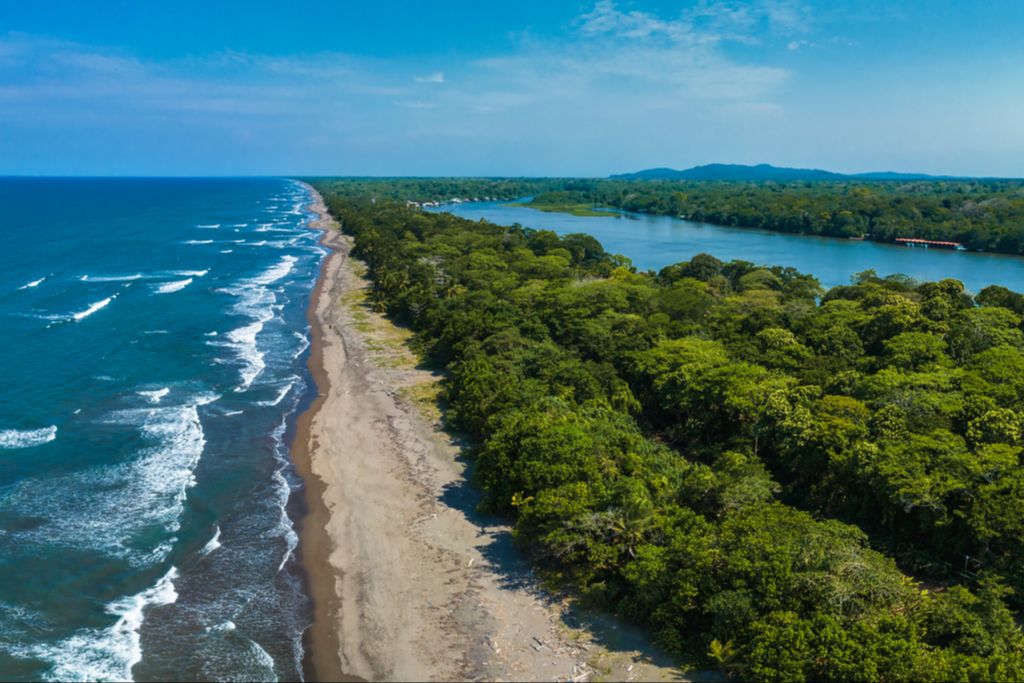While a relatively small country, Costa Rica has such a wealth of amazing destinations to consider. However, if you have around a week of travel time available, it’s possible to get a diverse impression of this unparalleled adventure and eco-tourism hotspot.
In this one week itinerary, I’ll focus on some of the best nature highlights, including the Monteverde Cloud Forest Reserve, the Arenal Volcano, and the Tortuguero National Park.
I’ll explain exactly how to get from A to B and what’s most worth doing in each location. To ensure you won’t waste much time in transit, this itinerary follows a fairly compact circular route, letting you fully experience each stop without rushing.
By the end of your itinerary, you’ll surely be living to the beat of the famous Costa Rican saying—Pura Vida!

Your 1-week Costa Rica itinerary in a nutshell
This template is for planning your Costa Rica trip. It starts in Monteverde and ends in Tortuguero. Each day includes suggestions for activities and accommodation.
P.S. You’ll notice San José, Costa Rica’s capital, isn’t on this itinerary — and that’s no accident. Truth is, you’re not missing much. With just one week, it’s better to skip the city and head straight for the real highlights: the lush, nature-packed regions. That’s why we’re starting things off in Monteverde — the perfect gateway to your Costa Rican adventure.
How to get from A to B
This itinerary can be done in two ways: by using shared transportation or by using your own car.
I recommend getting a rental car for maximum flexibility. It lets you depart any time and arrive exactly at your accommodation, so you’ll waste much less time. I also love how the journey on a road trip can become an integral part of the experience. You can make fun stops along the way — say, to grab that mango smoothie in a small village, or to enjoy a beautiful vista.
I was a bit apprehensive about driving in a Central American country, but the roads in Costa Rica are mostly in good shape. I had imagined horribly potholed roads everywhere (like I’d seen in Guatemala and elsewhere), but the main roads in Costa Rica are generally well-maintained. Traffic in and around the capital can be very chaotic, but once you’re on the open road, it’s fairly smooth sailing.
Costa Rica is actually quite car-centric. Locals told me the quality of public transportation went down over the years as road quality improved and more people started owning private cars.
The main roads are asphalted and quite easy to drive, but you may still want to get a 4WD, particularly for the road between Monteverde and La Fortuna. It isn’t an absolute necessity during the dry season (December-April), but it’s recommended during the rainy season (May-November) when some roads can become muddy and slippery. If you’re feeling adventurous, having a 4WD can also let you go to some of those lesser-known, off-the-map spots.
View available car rentals  TIP: Be sure to check the 4×4 search option on Discovercars
TIP: Be sure to check the 4×4 search option on Discovercars
Public transport is another option, but it will be slower and less convenient. I do like the buses in Costa Rica, which tend to be modern buses and much less commonly the old converted US school buses (‘chicken buses’) that you find in neighboring countries. However, services can be quite infrequent and slow. For instance, there are just two daily services between San Jose and Monteverde, our first stop in this itinerary. It’s ok if you’re a backpacker with plenty of time, but it’s not ideal for a snappy holiday itinerary. If you’re taking buses, I suggest 8 or 9 days for this itinerary to allow for increased transit times.
As a tourist, it can actually be much more convenient to get around using a shared tourist minibus shuttle service. The downside is that they’re a lot more expensive than public buses (e.g. it’s $60 per person to Monteverde instead of $6 by bus). The upside is that on many routes, they go many times a day, and they go direct point-to-point between tourist destinations without any need for stops or changeovers. You could even opt for a private transfer by car or minibus.
The best place I know where you can book regularly scheduled tourist minivans online is Bookaway.com. They also list various options for private transfers. I will later link to Bookaway for each leg in this itinerary.
Check Transport options
Days 1 & 2: Monteverde
Monteverde is tucked away in the Cordillera de Tilarán mountains, which means reaching it requires some effort, but the journey is definitely worth it. From San José, you’ll be driving around 3.5-4.5 hours, depending on traffic and weather conditions.
The Monteverde Biological Preserve is a misty mountain paradise famous for its cloud forests teeming with unique biodiversity. Suspended bridges weave through the verdant canopy, offering breathtaking views and the chance to spot exotic wildlife.
By car: It’s about a 3 1/2 hour drive from the San Jose airport to Santa Elena, the town from which you can access the Monteverde Cloud Forest Reserve. It’s a gorgeous drive on well-paved roads through the mountains, so take your time and enjoy the views. (Part of the route used to be unpaved, but this is no longer the case!)
By organized transit: By bus, it’s a 4.5 hour drive, going twice a day from Terminal 7-10 in downtown San Jose. Alternatively, check options for tourist shuttles or private minivans.
It may sound silly, but when I first visited many years ago, I actually had no idea what a cloud forest was! I just thought it sounded mysterious and interesting.
Cloud forests are, of course, found in places where clouds regularly get trapped against a mountain rim, resulting in wet conditions and a persistent fog. The jungles of Monteverde are lush, mossy, fern-covered, and home to a huge degree of biodiversity. It’s a very specific ecosystem that makes it the perfect place to see lots of flora and fauna.
The most unique aspect of staying in Monteverde is waking up surrounded by swirling mist that parts occasionally to reveal breathtaking views of the mountains. Going on a hike through the fog-draped forests is a must, as well as ziplining, visiting butterfly gardens, or touring a local coffee farm.
If you want to really soak it all in, stay somewhere tucked into nature. Here are a few of my favorite spots:
How to kick off day 1 in Monteverde
Monteverde literally means “Green Mountain,” and you’ll get it the moment you arrive. Perched 4,662 feet above sea level along Costa Rica’s continental divide, it boasts a rare microclimate you can feel the second you step in, thanks to the fog. A soft, rolling mist drifts through the forest almost all day, giving the landscape a dreamlike atmosphere.
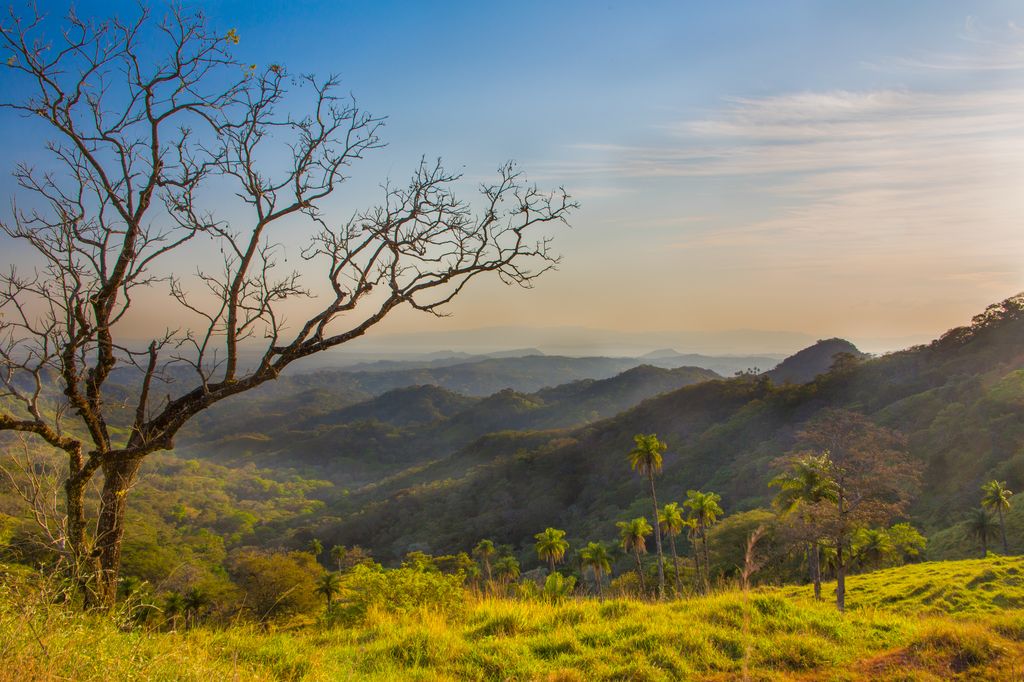 A sneak peek of Monteverde on a foggy day
A sneak peek of Monteverde on a foggy day 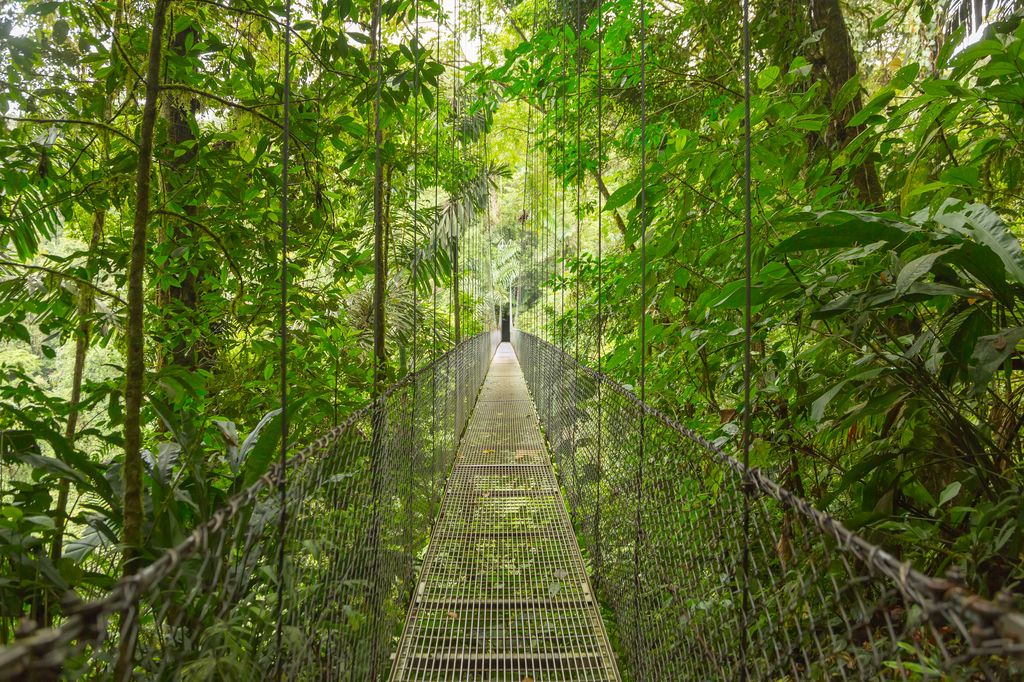 This hanging bridge lets you stroll high above the canopy of Monteverde’s cloud forest
This hanging bridge lets you stroll high above the canopy of Monteverde’s cloud forest
Check into your hotel in Santa Elena, then take it easy on your first day, since your first and only full day in Monteverde will be packed solid.
Some of the best things to do on your half day:
There’s also a ton of hiking trails in the area if you’re feeling up for some adventure.
In the evening, make sure to make a reservation at the tree house in Santa Elena. It’s one of the coolest restaurants in the whole country. Situated inside a giant tree house, you’ll be able to watch the forest canopy as you enjoy some delicious food
The highlight: Monteverde Cloud Forest
Waste zero time on your first full day in Costa Rica by heading out early in the morning on an adventure tour through the Monteverde cloud forest.
I highly recommend doing this with a guide, as without one, you’ll surely be oblivious to much of the fascinating fauna and flora along the way. My guide did a phenomenal job of showing all kinds of interesting things, including bright red poison dart frogs hidden among the dense foliage and tarantulas hiding in their burrows.
You can go on a regular wildlife-spotting tour that involves simply guided hiking, or you can spice things up with the adventure version of this tour. Besides offering an up-close walking introduction to nature, you’ll also get to walk across hanging bridges and zip line through the trees. With over 15 platforms, you’ll see some of the craziest views of the clouds and be surrounded by lush greenery.
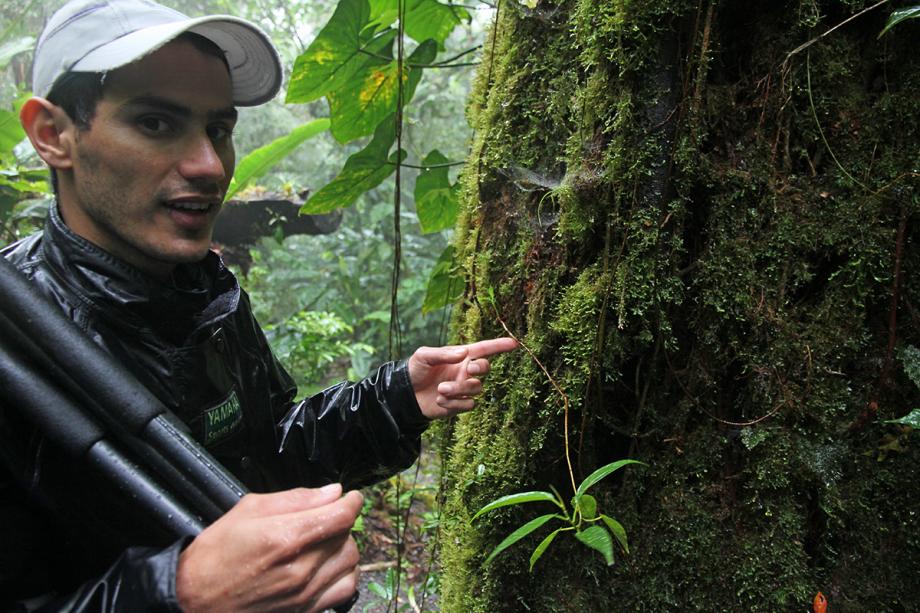 Moss blankets the tree trunks, nourished by the constant mist of this high-altitude rainforest.
Moss blankets the tree trunks, nourished by the constant mist of this high-altitude rainforest.  Always misty, always lush—Monteverde’s cloud forest is bursting with moss, orchids, and rare creatures.
Always misty, always lush—Monteverde’s cloud forest is bursting with moss, orchids, and rare creatures.
After a full day in the cloud forest, head back to Santa Elena and grab a bite to eat at one of the local restaurants. A typical Costa Rican dish will include rice and beans, grilled meat, and some yummy fried plantains.
If you still have some energy left, take a night tour through the Monteverde Cloud Forest. You’ll have the chance to see some crazy-colored frogs, bats, coati bears, and even some gorgeous owls as your local guide takes you through the reserve.
I highly recommend doing the night tour if you can, as it will reveal many creatures that are nocturnal or simply much harder to spot during the day. Luck will always be a factor in what you’ll get to see exactly, but when I went on the night tour, I saw a whole host of animals, including a coati and several sloths, which was simply unforgettable.
Exploring a rainforest by flashlight is one of those bucket list adventures you didn’t know you needed—until now. It’s an immersive dive into the sights, sounds, and mystery that make Monteverde’s night tours truly unforgettable.
Join this guided experience to experience the vibrant nocturnal life of the tropical forest, from elusive kinkajous and armadillos to colorful frogs, insects, and more.
Days 3 & 4: La Fortuna
Take your time enjoying a morning coffee before making your way to La Fortuna. Although Santa Elena and La Fortuna may not seem far apart as the crow flies, it’s actually about a 3-hour drive from Monteverde because you have to go around the jungle and the lake first.
But trust me, La Fortuna is probably one of the best places in Costa Rica. It’s home to the iconic Arenal Volcano, where you’ll have a plethora of activities to choose from and some pretty gnarly hikes.
By car: It’s about a 3 1/2 hour drive from Monteverde to La Fortuna. It’s a very scenic route! However, it can be a somewhat challenging drive, with many turns, some gravel or potholed sections, and poor lighting conditions at night. It’s a good idea to do this whole drive during the day and to take it easy.
By organized transit: Check options for tourist shuttles or private minivans on Bookaway. One interesting option is the jeep-boat-jeep ticket, which combines driving sections with a quick ferry across the lake, cutting down the overall travel time.
Two days in La Fortuna will be gone in a blink, so you want to make the absolute most of your time in the town. Once you arrive, check in, drop your bags, and get out there. (Don’t worry, I’ve included some relaxing activities as well!)
For the afternoon, you have a few options depending on your energy levels:
- High-adrenaline river adventure: If you’re feeling up for it, you can join a white-water rafting tour through the Balsa River. Your adrenaline will be pumping as you paddle through class III and IV rapids, surrounded by the sights and sounds of nature.
- River safari & wildlife spotting: Or, if you want to get in the river but maybe take it a little slower, you can join a wildlife safari float on the Penas Blancas River. Your guide will help you spot monkeys, sloths, and maybe even some caimans along the way.
- Rainforest chocolate tour: If water isn’t your thing, join a chocolate tour where you can see how chocolate is made from bean to bar before being exported to the rest of the world. You’ll be able to see the cacao plant and even try it before it’s turned into delicious chocolate.
You’ll want to get a good night’s rest because tomorrow is a full day of hiking, adventuring, and all the best of La Fortuna.
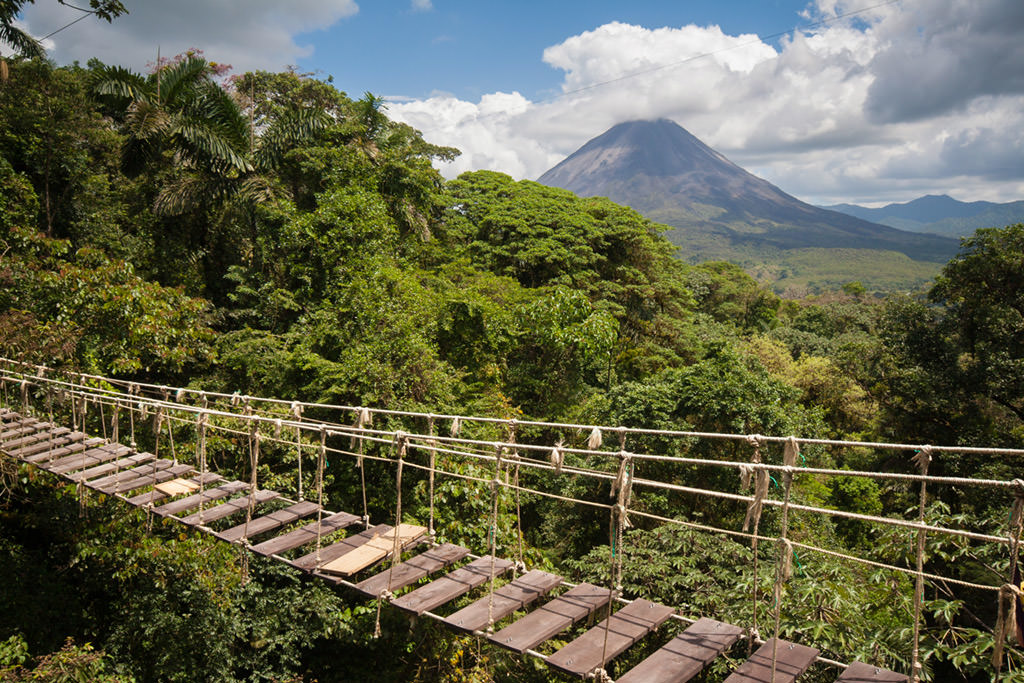 Hanging bridge views with Arenal Volcano in the distance
Hanging bridge views with Arenal Volcano in the distance
The highlight: Arenal Volcano
La Fortuna is most famous for the Arenal Volcano. The volcano has been dormant since 2010, but that hasn’t stopped it from being a must-see attraction for visitors.
Loads of tours can take you on guided hikes through the rainforest, where you’ll get to go swimming in the La Fortuna waterfall and visit a few different unique stops along the way before arriving at the breathtaking view of the Arenal Volcano. It’s a 3.3-mile in-and-out trail, so make sure to bring good shoes.
It’s a day full of outdoor adventure, and the best way to end it is by soaking in one of the many hot springs in the area.
If you want to explore on your own, you can enter the Arenal Volcano National Park and hike at your leisure. I recommend stopping at the Mistico Arenal Hanging Bridges Park, where you can walk through the treetops and get a bird’s-eye view of the park.
If you only do one thing during your 2 days in La Fortuna, make it this — and this guided tour makes it effortless:
Go on a short jungle hike to the iconic La Fortuna Waterfall—yep, you can swim at the bottom. Then swing by an Indigenous village for a bit of culture and a classic Costa Rican lunch.
After that, hike through old lava trails at Arenal Volcano and catch some unreal views of the lake and surrounding rainforest. Wrap it all up by kicking back in natural hot springs, cocktail in hand.
Loved La Fortuna? Here’s more nearby
If you’re a huge nature junkie, then you could probably spend the whole week just in and around La Fortuna. If you have a couple of extra days, here are some great day trips from La Fortuna:
- Waterfall & wildlife: Head to Tenorio Volcano National Park to witness a gorgeous blue waterfall and some serious wildlife. The waterfall is at the end of a 3.4-mile trail in Tenorio Volcano National Park. It’s about a 1 1/2 drive from La Fortuna and is a great place to spend the morning.
- Underground caves: Go deep underground at the Venado caves, only about 45 minutes from La Fortuna. You’ll be guided through an underground system of grottos and caverns full of stalactites and stalagmites. You’ll have to crawl through some small and tight spaces but end up in huge caverns with beautiful formations.
Regardless of how you choose to schedule your two days in La Fortuna, you’re going to have an epic time discovering why Costa Rica has become a top nature travel destination.
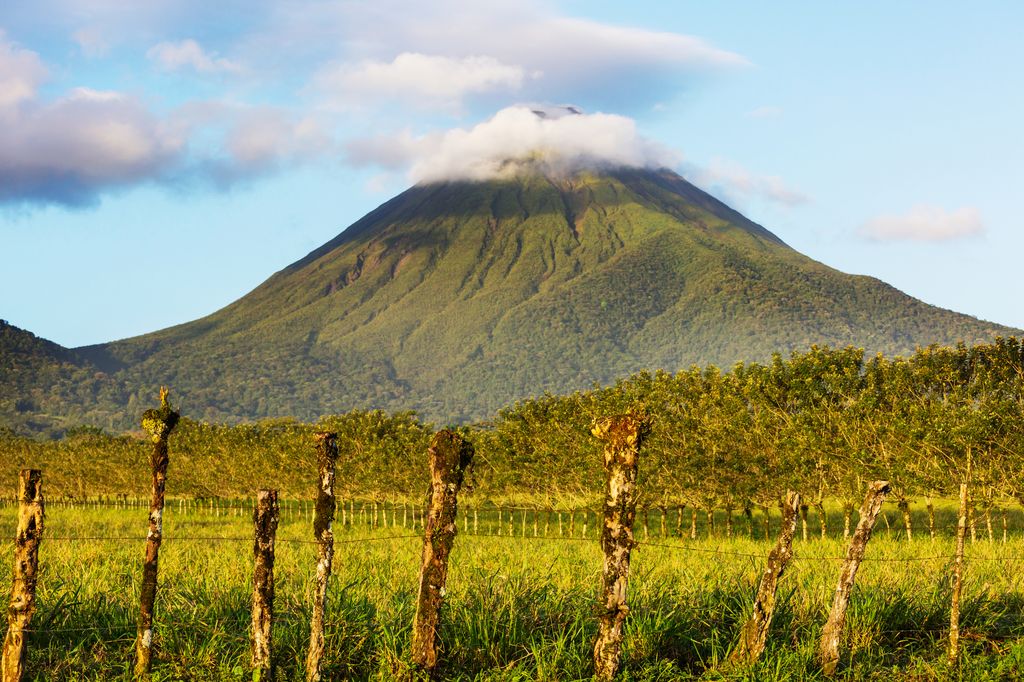 Behold the majestic Arenal Volcano
Behold the majestic Arenal Volcano 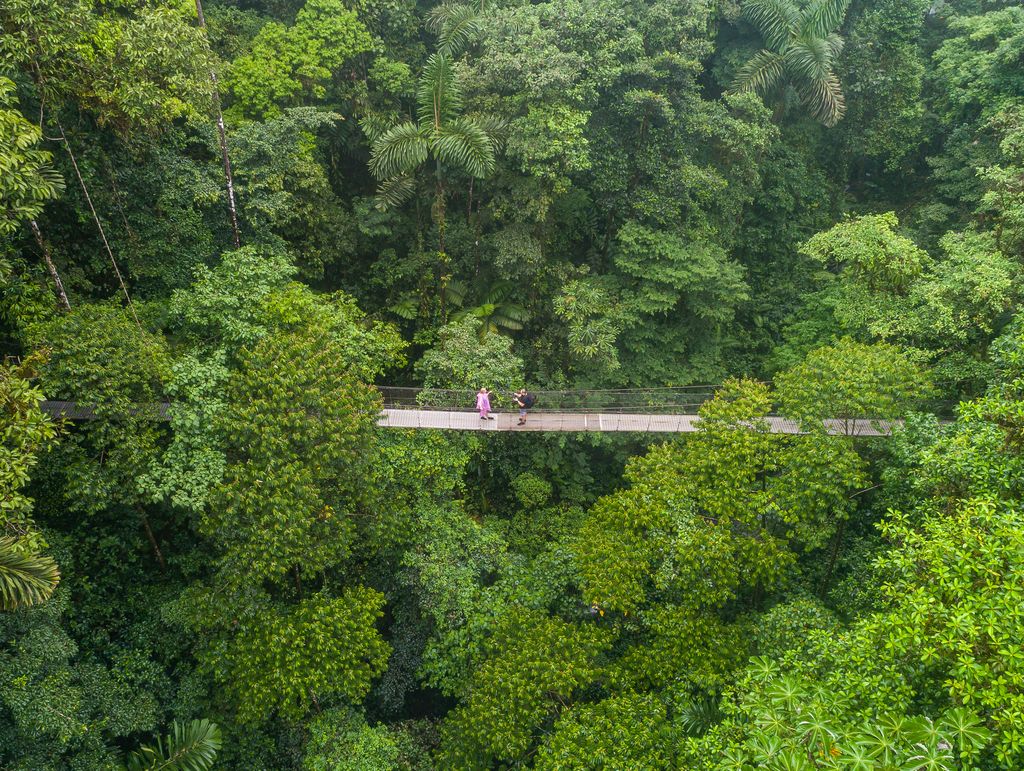 A bird’s-eye view from Mistico Hanging Bridge
A bird’s-eye view from Mistico Hanging Bridge
Where to stay in La Fortuna
The unique volcanic setting of Arenal transforms where you stay in La Fortuna into an integral part of your experience. Some spots feel like a jungle hideout, others are scenic getaways with front-row volcano views. The best thing you can do is figure out what kind of trip you want—and pick a place that matches that. Once you’ve got that locked in, everything else falls into place.
Days 5 & 6: Tortuguero
Located on the northeastern coast of Costa Rica, Tortuguero is a place unlike anywhere else. While a lot of people head to the Pacific to catch some waves, I think there is something truly special about the Caribbean side that will really drive home how amazing this country is.
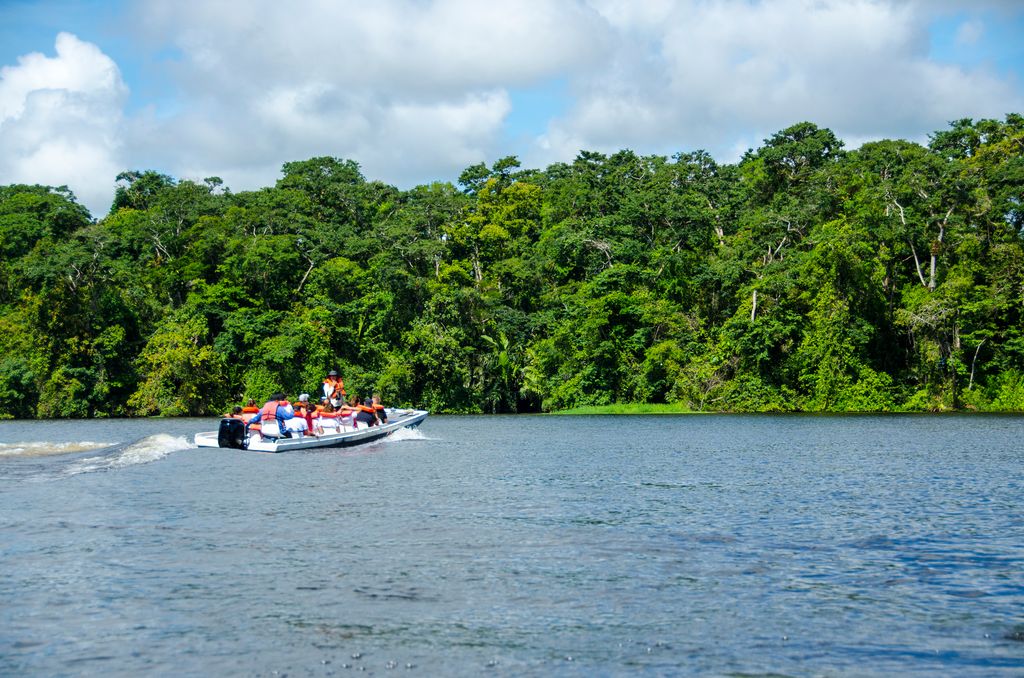
Tortuguero logistics 101: arrival, rides & where to stay
Arrival: The journey to Tortuguero by car is around 5 hours, but you’ll be passing through little towns and can stop if you want to stretch your legs. The roads on this travel day are mostly straight, in good condition, and easy to drive, so you can cover lots of ground quickly.
Once you reach the coastal town of La Pavona, you can leave your car at the dock for $10 a day. (Lots of travelers do this, so you shouldn’t feel any sort of apprehension. The parking lot is guarded at night, however, I still wouldn’t leave any valuables just to be sure.)
You’ll then hop on a boat that will take you through the jungle canals to your hotel in Tortuguero. It costs $3 and takes about an hour, but consider it an additional activity. You’ll be able to spot wildlife along the river and get a taste of the local way of life in this remote area.
Your second option is to head back to San Jose from La Fortuna and catch a short 30-minute flight to Tortuguero itself. It costs about $250 round-trip. You’ll fly directly into the island, bypassing the commute and boat ride altogether.
Where to stay: Upon arrival, you’ll want to stay somewhere that truly captures the essence of Tortuguero. Since the village is surrounded by nature, many of the hotels are designed to blend in with the environment, so you’re guaranteed an authentic and immersive experience. The picks below will give you a glimpse of what to expect from the accommodation scene in Tortuguero.
The highlight: river canals & sea turtles
If you’re big on wildlife or specifically love turtles, then you’re about to be in heaven. Tortuguero translates to “Land of the Turtles”, and it’s one of the world’s most important nesting sites for more than one turtle species in the country.
It’s a small area, and it’s super remote, so there are only a few things to do while you’re here. It’s the perfect time to relax after nonstop hiking and exploring.
 A peaceful moment
A peaceful moment  Tortuguero blending rainforest and coastline
Tortuguero blending rainforest and coastline
Every year during the nesting season from July to October, thousands of sea turtles make an incredible journey back to the beaches of Tortuguero, the very place where they were born. They haul themselves onto the shore, dig deep nests in the sand, and lay dozens of eggs before returning to the sea.
As magical as it is to actually experience it, this process is fragile. Using a flashlight, making loud noises, or even just being too close can stress the turtles, sometimes stopping them from nesting altogether. That’s why it’s important to be aware of this and avoid unregulated tours or anything that might disrupt this sacred moment.
If you do choose to see it, always go with a certified local guide who follows strict conservation protocols. I encourage you to do your own research and confirm any tour you choose adheres to strict rules to minimize disturbance.
Besides the turtle hatching that Tortuguero is famed for, the surrounding jungles are home to plenty of other wildlife.
You’ll want to get a good sleep here because all the activities take place at the crack of dawn, but that’s when the wildlife is most active. Morning tours will take you through the rainforest, where you have the opportunity to see some pretty incredible animals like ocelots, manatees, and vibrant tropical birds.
Your time in Tortuguero is the epitome of Pura Vida. Days are long and relaxing. You can head to the village to meet the locals and just take in the last few days of your Costa Rican vacation.
A one-day adventure that checks all the boxes—nature, wildlife, and a taste of local life in Tortuguero.
You’ll cruise past coffee farms and mountains, then hop on a boat through jungle canals. Keep your eyes peeled for monkeys, toucans, crocs—maybe even a turtle or two.
And the best part is that you get to stop by Tortuguero Village and see the heart of the community and its conservation efforts. It’s low-key, one of the best ways to wrap up your Costa Rica trip.
Day 7: return to San Jose and fly out
You’ll want to give yourself ample time to get back to the city to catch your flight. Remember you’ll have to take a boat back to the mainland, and then you still have a 3 1/2 hour drive back to the airport.
If you time it right, you can catch a morning boat to get back to San Jose in time for lunch and visit the central market to pick up some souvenirs for everyone at home.
And there we have it: my epic 1-week itinerary for Costa Rica. From the city to the beach, you’ll absolutely fall in love with this small country in Central America.
